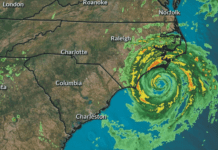On May 1, President Clinton announced that the selective availability (SA) system used to degrade GPS (global positioning system) signals was terminated, effective at midnight that day. SA had been in place ever since GPS was made available to the public in the early 1980s. Despite the efforts of various boaters advocacy groups, including BOAT/U.S., to rescind SA, the government staunchly insisted SA was necessary to national security. Without SA in place, terrorists or hostile nations, they reasoned, could use GPS to guide missiles at strategic US targets.
SA degraded GPS accuracy from about 30 to 300 feet. If you periodically plotted positions on a graph, as we did in the July 1, 1995 issue, you ended up with a scattergram. In other words, your position wandered.
Still, 300 feet wasnt bad, and critics of SA liked to point out that if terrorists indeed used GPS to aim a missile at the White House, they might instead hit the Executive Office Building across the street.
In a government boondoggle, it implemented DGPS (differential GPS), a network of coastal ground stations (sort of like Loran) that, with the addition of a black box to your GPS, could cancel SA errors. It cost millions. DGPS boxes were sold by all major marine retailers and one supposes that West Marine and BOAT/U.S. store clerks were not doing background checks to see if their customers had ties to Bin Laden.
With the demise of SA, DGPS still works, but is it needed? What the government will do with all its DGPS stations is anyones guess-perhaps keep them on standby in the event America has to go on red alert and reinstitute SA? (But Clinton noted that the US has the capability to selectively deny GPS signals on a regional basis when our national security is threatened.)
Anyway, the first thing I did when I heard the news was plot the position of our office building on a chart, grab a handheld GPS, and run outside into the parking lot to see if the two agreed.
Our plotted position was N41 35′ 2″, W71 17′ 20″.
The GPS gave my position as N41 35.0415′, W71 17.031′.
Well rats! My GPS doesn’t give lat/lon in seconds, rather fractions of minutes. In any case, I was darn close to my plotted position.
I began walking around the building, trying to bring up my plotted position on the GPS. It couldnt be done. After circling the entire building, it dawned on me-my plotted position was inside the building!
Next I plotted a position at the nearby intersection of two large ship piers shown on the chart. Then I walked to that spot with the GPS in hand. The plotted position was N41 35′ 2″, W71 17′ 21″. When I got to what I reckoned was the plotted spot, the GPS displayed N41 35.045′, W71 17.316′. Converting the fractions of minutes to seconds gave me N41 35′ 2.2″, W71 17′ 19″. Converting the second errors to feet, I figured latitude was off by 20 feet and longitude by 200 feet.
Hey, what gives? The 20-foot error is within the claimed 30-foot circle of possible error, but 200 is way out.
A major part of the problem, at least in this instance, is the plotting of your position on a large scale chart. On a typical 1:40,000-scale coastal chart, the dot made by a dull #2 pencil is about 25 feet. On the 1:47,000-scale chart I used above, 1/4-inch equals roughly 1,000 feet, making the 200-foot discrepancy between plotted position and GPS about 1/20 inch.
In a second test, I returned to the same intersection a few days later to check for repeatability (a strong attribute of Loran). I stood as closely as I could to the same spot. Difference in positions was 7.2 and 10.8 inches!
When all is said and done, 30-foot GPS accuracy is great, but youll be hard pressed to plot positions on paper charts that closely.
-Dan Spurr




































